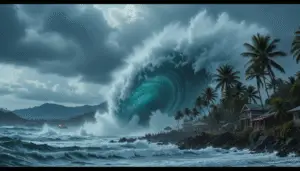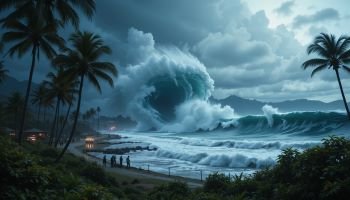Massive Quake Sparks Chaos: Tsunami Hits Hawaii and Alaska
A powerful 8.8-magnitude earthquake off Russia’s eastern coast sent a Pacific-wide tsunami to Hawaii and Alaska on Monday, prompting evacuations, flooding and waves from the Aleutian Islands to Maui.
Tsunami hits Hawaii and Alaska less than 10 hours after the quake struck near the Kamchatka Peninsula. Sirens blared, streets were jammed with cars and thousands of people rushed to higher ground as waves 4-6 feet hit several islands and coastal communities.
In Hawaii, waves of 5.7 feet were recorded at Kahului Harbor and 4.9 feet at Hilo Harbor. The most visible impacts were on Maui and the Big Island where water flooded low-lying areas and temporarily shut down beach access and harbor operations.
Kalani Moore, a fisherman in Hilo said “When I saw the water pull back, I knew we were in trouble. The last time we had something like this was years ago, but this one felt different. It was fast.”
Sirens sounded on Oahu and Maui around 7:00 p.m. local time. Roads inland quickly became congested. Officials credited early warnings and public cooperation for no casualties.
Tsunami hits Hawaii and Alaska as Pacific tectonic activity grows, scientists have long warned could produce trans-oceanic tsunamis under the right conditions. Monday’s quake, centered 80 miles southeast of Petropavlovsk-Kamchatsky, was at a relatively shallow depth of 18 kilometers—a key factor in tsunami formation.
Though the waves were not big, officials said they were still a big deal. In tsunamis, dangerous currents, unpredictable wave patterns and multiple surges often cause more harm than the initial impact.
Alaska Braces and Responds
As the tsunami moved east, warnings were issued across southern Alaska, especially the Aleutian Islands and Kodiak Island. While wave heights were generally lower than in Hawaii—1.4-2 feet—emergency crews in coastal villages quickly activated response plans. Harbormasters closed docks and told fishing boats to stay offshore or head to port. Tsunami hits Hawaii and Alaska in rapid succession with some Alaskan communities getting waves just 90 minutes after Hawaii’s first hit.
Sarah Reaves, a public safety officer in Kodiak said “We’ve practiced this, but you’re never really ready. As soon as we got the alert we sounded the sirens and moved fast.”
Wider Pacific Feels the Tremor
From Japan to Chile, dozens of Pacific nations issued tsunami alerts following the quake. Japan’s Meteorological Agency ordered evacuations for more than two million residents in its northern regions. Several communities in Hokkaido reported waves up to 3 meters. Authorities in Fukushima conducted precautionary checks on nuclear plants, though no damage was reported.
Closer to the epicenter, Russia’s Kuril Islands were among the hardest hit. Severo-Kurilsk experienced severe flooding as waves exceeding 5 meters crashed into its shoreline. Over 2,000 residents were moved to emergency shelters.
The global sweep of the event reinforced the destructive potential of Pacific seismic activity. NOAA official explained that “It’s the nature of this basin. When a big quake strikes the western Pacific, the energy moves fast and the entire rim is at risk.”
U.S. West Coast Watches Closely
While California, Oregon, and Washington were spared the brunt of the tsunami’s force, authorities issued advisories from San Diego to Seattle. Wave heights along the West Coast remained under 2 feet, but swift currents were reported at several ports, including Crescent City and Arena Cove.
Beaches, marinas, and waterfront parks were briefly closed as a precaution. The tsunami hits Hawaii and Alaska, but its shadow touched thousands of miles of coastline.
Also Read : Artificial Intelligence and Machine Learning: Everything You Need to Know in 2025
Aftermath and Reflection
By early Tuesday, Hawaii officials had downgraded the tsunami warning to an advisory. No fatalities or serious injuries were reported, though several waterfront areas sustained minor flooding and property damage.
Governor Josh Green commended residents for their response and emphasized the importance of emergency preparedness. “This was a serious threat, and the public responded exactly how they should. We’re grateful the impact wasn’t worse, but we can’t take these warnings lightly.”
As the tsunami hits Hawaii and Alaska, experts say the event serves as a vital test of emergency systems. From real-time modeling to public compliance, the Pacific’s disaster infrastructure was pushed to its limits—and held.
Dr. Nina Lowry, a geophysicist at the Pacific Tsunami Warning Center stated that “This was one of the strongest quakes in decades. We’re fortunate the wave sizes weren’t larger. But the system worked. People listened.”
For communities across the Pacific, the event will linger in memory. From the panic of evacuation to the calm that followed, the phrase tsunami hits Hawaii and Alaska is no longer a hypothetical. It’s now lived history.

Looking Ahead
With seismic data still under analysis and aftershocks possible, officials remain on alert. Though immediate danger has passed, coastal communities are being urged to review emergency plans and remain cautious.
The tsunami hits Hawaii and Alaska headline may fade in the coming days, but its lessons will linger—etched into Pacific memory as another reminder that the ocean, while beautiful, commands deep respect.
Also Read : Urgent: 5 Alarming Reasons US Warns China on Russian Oil Tariffs
📌 FAQ: Tsunami Hits Hawaii and Alaska
1. What caused the tsunami that hit Hawaii and Alaska?
The tsunami was triggered by a massive 8.8-magnitude undersea earthquake off Russia’s Kamchatka Peninsula. The quake displaced large volumes of water, generating tsunami waves that spread rapidly across the Pacific Ocean, eventually reaching Hawaii and Alaska.
2. How high were the tsunami waves in Hawaii and Alaska?
In Hawaii, waves reached up to 5.7 feet in Kahului and nearly 5 feet in Hilo. In Alaska, wave heights were slightly lower, generally ranging between 1.4 to 2 feet, but still strong enough to cause concern and activate emergency protocols.
3. Were there any casualties or injuries reported?
As of the latest reports, no casualties or major injuries have been confirmed. Authorities credited quick evacuations, public cooperation, and early warnings for preventing loss of life during the tsunami that hit Hawaii and Alaska.
4. How long did the tsunami threat last?
The main threat from the tsunami lasted several hours after the initial impact. Hawaii downgraded the warning to an advisory by early Tuesday morning, while Alaska remained on alert longer due to continued wave surges and strong currents.
5. Did the tsunami affect the U.S. mainland?
Yes, although not as severely. The U.S. West Coast, including California, Oregon, and Washington, experienced smaller wave surges of 1 to 2 feet, along with dangerous currents and precautionary closures of beaches and marinas.
6. How did local residents respond in Hawaii and Alaska?
In both states, residents evacuated low-lying areas swiftly, following emergency alerts. In Hawaii, some people drove uphill within minutes of hearing sirens. In Alaska, harbormasters and coastal communities enacted pre-planned safety measures.
7. Is this the first time a tsunami has hit Hawaii and Alaska?
No. Both Hawaii and Alaska have experienced tsunamis in the past. Notably, the 1964 Alaska earthquake generated a devastating tsunami, and Hawaii regularly conducts tsunami preparedness drills due to its location in the Pacific “Ring of Fire.”
8. Was this tsunami stronger than others in recent years?
While it wasn’t the most devastating in terms of damage, this tsunami was notable due to its Pacific-wide impact, swift wave travel, and its source: one of the largest earthquakes globally in recent decades.
9. What safety measures helped during the tsunami that hit Hawaii and Alaska?
The use of tsunami warning systems, early alerts from the Pacific Tsunami Warning Center, public awareness, and community evacuation plans played a key role in minimizing damage and saving lives during the event.
10. What should I do if another tsunami warning is issued?
Immediately move to higher ground if you’re in a coastal area, avoid beaches and harbors, and follow all official emergency instructions. Don’t wait to “see the wave”—many tsunami deaths occur because people underestimate the danger.
For all latest news updates about politics, entertainment, technology, health and economy do visit Premiere News website, Facebook, Instagram and Twitter accounts.




